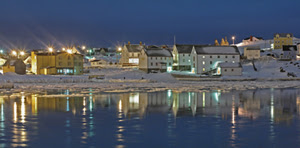 This week, we convened like we do every two months to judge the latest photo contest in our consumer magazine, here’s how! Every issue, we offer fantastic prizes for the top four photos, which we require to be digital in some respect, either taken with a digital camera, and/or manipulated on the PC in a program like Photoshop. We get hundreds of entries; some gorgeous, and others, well, my three-year old niece could take a better pic! Editor Gordon Brockhouse weeds them down to about 100 of the best, at which point, we gather to duke it out and select the winners.
This week, we convened like we do every two months to judge the latest photo contest in our consumer magazine, here’s how! Every issue, we offer fantastic prizes for the top four photos, which we require to be digital in some respect, either taken with a digital camera, and/or manipulated on the PC in a program like Photoshop. We get hundreds of entries; some gorgeous, and others, well, my three-year old niece could take a better pic! Editor Gordon Brockhouse weeds them down to about 100 of the best, at which point, we gather to duke it out and select the winners.Here’s how it works: the panel includes myself, Gordon, John Thomson, Associate Publisher, Robert Franner, Editor of Marketnews, and Erik Devantier, Creative Director. As we scroll through a widescreen slideshow of the pics, the personality of each judge becomes very apparent. Robert and Gordon are self-professed photo geeks, having studied the art for 30-plus years. Needless to say, their comments are more often than not based on the technical aspects of the photo: exposure, difficulty of getting such a shot, etc. A close-up photo of a bug on a leaf appears on screen and I automatically think “b-o-r-i-n-g”. But then these guys point out that getting such a shot is extremely difficult. OK, now I understand its appeal, and I’ll give the entrant a little more credit.
John, who’s also a major photo buff, tends to look more at the composition of the photo. Why didn’t he remove this distracting pole in the background? He/she should have cropped the picture like so in order to make it more powerful.
Creativity is, no surprise, Erik’s main concern. "This photo tells a story, and it keeps me interested," he says while observing an entrant’s photo. Given Erik’s expertise in creative direction and photo editing software, he can often times look at an image and tell exactly what the person did to alter it. "There’s no way that picture could have been taken with those items in the boat,” he instructs. “It looks like he Photoshopped them in.” Knowing how a photo was created, and the story behind it, makes it much more interesting to all of us.
And me. Well, I like to think that I bring a different perspective in many ways, not only by being part of another generation, but also of another sex. My main concern is how the photo makes me feel? If it doesn’t evoke some sort of emotion, whether laughter or sadness, or even intrigue, it’s not a winner in my books. Is it too cluttered? Confusing? Boring? Of an overplayed subject (if I see another shot of a flower or bird, I’m going to puke!)
It’s obvious that subjectivity plays a big role in the decision-making process for everyone, no matter how much the technical aspects do come into play. If you’re an animal lover, you’ll likely find a cute puppy pic endearing; whereas someone with severe pet allergies might shrug it off. If you have young kids, you’ll likely see a bit of your own son or daughter in a cutesy shot, and gravitate toward it as a favourite. Nevertheless, having a panel of five people deciding on the winners allows for many different perspectives, and for every aspect of photography to be taken into consideration.
Once the majority agree on the top 25 or so pics (which typically takes an hour or two, and a few words of disagreement), we each rank them in our order of preference. The results are tabulated, and there arises the two grand prize winners, two runners-up, and a few honourable mentions.
And I bet you thought we just picked them from a hat!
To see the winning images from our latest photo contest, check out the upcoming June issue of here’s how! magazine. You can also browse through all past content winning photos on our Website (scroll to the bottom of the page).
[Photo: The photo depicted above was one of two winning photos from our April 2007 photo contest. Taken by Tony Seaward of Bonavista, Nfld., the image depicts Bonavista Harbour on a calm, March night. Seaward told Gordon that he used a Canon EOS Digital Rebel XTi and 50mm f/1.8 lens; and shot the scene with a 10-second exposure at f/6.3 and ISO 800. Once transferred to PC, he used Noiseware software to crop it, and Photoshop CS2 to make adjustments to the lighting.]

No comments:
Post a Comment